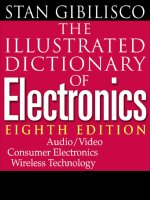Tài liệu STEP 2000 - Basics of PLCs doc
Bạn đang xem bản rút gọn của tài liệu. Xem và tải ngay bản đầy đủ của tài liệu tại đây (3.84 MB, 89 trang )
STEP 2000
Basics of PLCs
1
Table of Contents
Introduction 2
PLCs 4
Number Systems 8
Terminology 14
Basic Requirements 23
S7-200 Micro PLCs 28
Connecting External Devices 39
Programming A PLC 41
Discrete Inputs/Outputs 49
Analog Inputs and Outputs 61
Timers 64
Counters 71
High-Speed Instructions 75
Specialized Expansion Modules 78
Review Answers 84
Final Exam 85
2
Introduction
Welcome to another course in the STEP 2000 series, Siemens
Technical Education Program, designed to prepare our
distributors to sell Siemens Energy & Automation products
more effectively. This course covers Basics of PLCs and related
products.
Upon completion of Basics of PLCs you should be able to:
• Identify the major components of a PLC and describe
their functions
• Convert numbers from decimal to binary, BCD, and
hexadecimal
• Identify typical discrete and analog inputs and outputs
• Read a basic ladder logic diagram and statement list
• Identify operational differences between different S7-200
models
• Identify the proper manual to refer to for programming or
installation of an S7-200 PLC
• Connect a simple discrete input and output to an S7-200
• Select the proper expansion module for analog inputs and
outputs
• Describe the operation of timers and counters
3
This knowledge will help you better understand customer
applications. In addition, you will be better able to describe
products to customers and determine important differences
between products. You should complete Basics of Electricity
before attempting Basics of PLCs. An understanding of many
of the concepts covered in Basics of Electricity is required
for Basics of PLCs. In addition you may wish to complete
Basics of Control Components. Devices covered in Basics
of Control Components are used with programmable logic
controllers.
If you are an employee of a Siemens Energy & Automation
authorized distributor, fill out the final exam tear-out card and
mail in the card. We will mail you a certificate of completion if
you score a passing grade. Good luck with your efforts.
SIMATIC, STEP 7, STEP 7-Micro, STEP 7-Micro/WIN, PG 702,
and PG 740 are registered trademarks of Siemens Energy &
Automation, Inc.
Other trademarks are the property of their respective owners.
4
PLCs
Programmable Logic Controllers (PLCs), also referred to as
programmable controllers, are in the computer family. They are
used in commercial and industrial applications. A PLC monitors
inputs, makes decisions based on its program, and controls
outputs to automate a process or machine. This course is meant
to supply you with basic information on the functions and
configurations of PLCs.
5
Basic PLC Operation PLCs consist of input modules or points, a Central Processing
Unit (CPU), and output modules or points. An input accepts a
variety of digital or analog signals from various field devices
(sensors) and converts them into a logic signal that can be used
by the CPU. The CPU makes decisions and executes control
instructions based on program instructions in memory. Output
modules convert control instructions from the CPU into a digital
or analog signal that can be used to control various field devices
(actuators). A programming device is used to input the desired
instructions. These instructions determine what the PLC will do
for a specific input. An operator interface device allows process
information to be displayed and new control parameters to be
entered.
Pushbuttons (sensors), in this simple example, connected to
PLC inputs, can be used to start and stop a motor connected to
a PLC through a motor starter (actuator).
6
Hard-Wired Control Prior to PLCs, many of these control tasks were solved with
contactor or relay controls. This is often referred to as hard-
wired control. Circuit diagrams had to be designed, electrical
components specified and installed, and wiring lists created.
Electricians would then wire the components necessary to
perform a specific task. If an error was made the wires had
to be reconnected correctly. A change in function or system
expansion required extensive component changes and rewiring.
OL
M
CR
CR
L1
T1
T2
T3
L2
L3
OL
OL
OL
M
M
CR
M
Motor
Start
Stop
460 VAC
24 VAC
1
2
Advantages of PLCs The same, as well as more complex tasks, can be done with
a PLC. Wiring between devices and relay contacts is done in
the PLC program. Hard-wiring, though still required to connect
field devices, is less intensive. Modifying the application and
correcting errors are easier to handle. It is easier to create and
change a program in a PLC than it is to wire and rewire a circuit.
Following are just a few of the advantages of PLCs:
• Smaller physical size than hard-wire solutions.
• Easier and faster to make changes.
• PLCs have integrated diagnostics and override functions.
• Diagnostics are centrally available.
• Applications can be immediately documented.
• Applications can be duplicated faster and less expensively.
7
Siemens PLCs Siemens makes several PLC product lines in the SIMATIC® S7
family. They are: S7-200, S7-300, and S7-400.
S7-200 The S7-200 is referred to as a micro PLC because of its small
size. The S7-200 has a brick design which means that the
power supply and I/O are on-board. The S7-200 can be used on
smaller, stand-alone applications such as elevators, car washes,
or mixing machines. It can also be used on more complex
industrial applications such as bottling and packaging machines.
S7-300 and S7-400 The S7-300 and S7-400 PLCs are used in more complex
applications that support a greater number of I/O points. Both
PLCs are modular and expandable. The power supply and I/O
consist of separate modules connected to the CPU. Choosing
either the S7-300 or S7-400 depends on the complexity of
the task and possible future expansion. Your Siemens sales
representative can provide you with additional information on
any of the Siemens PLCs.
8
Number Systems
Since a PLC is a computer, it stores information in the form of
On or Off conditions (1 or 0), referred to as binary digits (bits).
Sometimes binary digits are used individually and sometimes
they are used to represent numerical values.
Decimal System Various number systems are used by PLCs. All number systems
have the same three characteristics: digits, base, weight. The
decimal system, which is commonly used in everyday life, has
the following characteristics:
Ten digits 0, 1, 2, 3, 4, 5, 6, 7, 8, 9
Base 10
Weights 1, 10, 100, 1000,
Binary System The binary system is used by programmable controllers. The
binary system has the following characteristics:
Two digits 0, 1
Base 2
Weights Powers of base 2 (1, 2, 4, 8, 16, )
In the binary system 1s and 0s are arranged into columns. Each
column is weighted. The first column has a binary weight of
2
0
. This is equivalent to a decimal 1. This is referred to as the
least significant bit. The binary weight is doubled with each
succeeding column. The next column, for example, has a weight
of 2
1
, which is equivalent to a decimal 2. The decimal value is
doubled in each successive column. The number in the far left
hand column is referred to as the most significant bit. In this
example, the most significant bit has a binary weight of 2
7
. This
is equivalent to a decimal 128.
9
Converting Binary The following steps can be used to interpret a decimal
to Decimal number from a binary value.
1) Search from least to most significant bit for 1s.
2) Write down the decimal representation of each column
containing a 1.
3) Add the column values.
In the following example, the fourth and fifth columns from the
right contain a 1. The decimal value of the fourth column from
the right is 8, and the decimal value of the fifth column from
the right is 16. The decimal equivalent of this binary number is
24. The sum of all the weighted columns that contain a 1 is the
decimal number that the PLC has stored.
In the following example the fourth and sixth columns from the
right contain a 1. The decimal value of the fourth column from
the right is 8, and the decimal value of the sixth column from
the right is 32. The decimal equivalent of this binary number is
40.
Bits, Bytes, and Words Each binary piece of data is a bit. Eight bits make up one byte.
Two bytes, or 16 bits, make up one word.
10
Logic 0, Logic 1 Programmable controllers can only understand a signal that
is On or Off (present or not present). The binary system is a
system in which there are only two numbers, 1 and 0. Binary 1
indicates that a signal is present, or the switch is On. Binary 0
indicates that the signal is not present, or the switch is Off.
BCD Binary-Coded Decimal (BCD) are decimal numbers where
each digit is represented by a four-bit binary number. BCD is
commonly used with input and output devices. A thumbwheel
switch is one example of an input device that uses BCD. The
binary numbers are broken into groups of four bits, each group
representing a decimal equivalent. A four-digit thumbwheel
switch, like the one shown here, would control 16 (4 x 4) PLC
inputs.
11
Hexadecimal Hexadecimal is another system used in PLCs. The hexadecimal
system has the following characteristics:
16 digits 0, 1, 2, 3, 4, 5, 6, 7, 8, 9, A, B, C, D, E, F
Base 16
Weights Powers of base 16 (1, 16, 256, 4096 )
The ten digits of the decimal system are used for the first ten
digits of the hexadecimal system. The first six letters of the
alphabet are used for the remaining six digits.
A = 10 D = 13
B = 11 E = 14
C = 12 F = 15
The hexadecimal system is used in PLCs because it allows the
status of a large number of binary bits to be represented in a
small space such as on a computer screen or programming
device display. Each hexadecimal digit represents the exact
status of four binary bits. To convert a decimal number to a
hexadecimal number the decimal number is divided by the base
of 16. To convert decimal 28, for example, to hexadecimal:
Decimal 28 divided by 16 is 1 with a remainder of 12. Twelve is
equivalent to C in hexadecimal. The hexadecimal equivalent of
decimal 28 is 1C.
The decimal value of a hexadecimal number is obtained by
multiplying the individual hexadecimal digits by the base 16
weight and then adding the results. In the following example
the hexadecimal number 2B is converted to its decimal
equivalent of 43.
16
0
= 1
16
1
= 16
B = 11
12
Conversion of Numbers The following chart shows a few numeric values in decimal,
binary, BCD, and hexadecimal representation.
13
Review 1
1. Identify the following:
2. The binary number system has a base ____________ .
3. The hexadecimal number system has a base
____________ .
4. Convert a decimal 10 to the following:
Binary ____________
BCD ____________
Hexadecimal ____________
14
Terminology
The language of PLCs consists of a commonly used set
of terms; many of which are unique to PLCs. In order to
understand the ideas and concepts of PLCs, an understanding
of these terms is necessary.
Sensor A sensor is a device that converts a physical condition into an
electrical signal for use by the PLC. Sensors are connected to
the input of a PLC. A pushbutton is one example of a sensor
that is connected to the PLC input. An electrical signal is sent
from the pushbutton to the PLC indicating the condition (open/
closed) of the pushbutton contacts.
Actuators Actuators convert an electrical signal from the PLC into a
physical condition. Actuators are connected to the PLC output.
A motor starter is one example of an actuator that is connected
to the PLC output. Depending on the output PLC signal the
motor starter will either start or stop the motor.
15
Discrete Input A discrete input, also referred to as a digital input, is an input
that is either in an ON or OFF condition. Pushbuttons, toggle
switches, limit switches, proximity switches, and contact
closures are examples of discrete sensors which are connected
to the PLCs discrete or digital inputs. In the ON condition a
discrete input may be referred to as a logic 1 or a logic high. In
the OFF condition a discrete input may be referred to as a logic
0 or a logic low.
A Normally Open (NO) pushbutton is used in the following
example. One side of the pushbutton is connected to the first
PLC input. The other side of the pushbutton is connected to an
internal 24 VDC power supply. Many PLCs require a separate
power supply to power the inputs. In the open state, no voltage
is present at the PLC input. This is the OFF condition. When the
pushbutton is depressed, 24 VDC is applied to the PLC input.
This is the ON condition.
16
Analog Inputs An analog input is an input signal that has a continuous signal.
Typical analog inputs may vary from 0 to 20 milliamps, 4 to 20
milliamps, or 0 to 10 volts. In the following example, a level
transmitter monitors the level of liquid in a tank. Depending on
the level transmitter, the signal to the PLC can either increase or
decrease as the level increases or decreases.
Discrete Outputs A discrete output is an output that is either in an ON or OFF
condition. Solenoids, contactor coils, and lamps are examples
of actuator devices connected to discrete outputs. Discrete
outputs may also be referred to as digital outputs. In the
following example, a lamp can be turned on or off by the PLC
output it is connected to.
17
Analog Outputs An analog output is an output signal that has a continuous
signal. The output may be as simple as a 0-10 VDC level that
drives an analog meter. Examples of analog meter outputs are
speed, weight, and temperature. The output signal may also
be used on more complex applications such as a current-to-
pneumatic transducer that controls an air-operated flow-control
valve.
CPU The central processor unit (CPU) is a microprocessor system
that contains the system memory and is the PLC decision-
making unit. The CPU monitors the inputs and makes decisions
based on instructions held in the program memory. The
CPU performs relay, counting, timing, data comparison, and
sequential operations.
18
Programming A program consists of one or more instructions that accomplish
a task. Programming a PLC is simply constructing a set of
instructions. There are several ways to look at a program such
as ladder logic, statement lists, or function block diagrams.
Ladder Logic Ladder logic (LAD) is one programming language used
with PLCs. Ladder logic uses components that resemble
elements used in a line diagram format to describe hard-wired
control. Refer to the STEP 2000 course Basics of Control
Components for more information on line diagrams.
STEP 2000
Basics of
Control
Components
Ladder Logic Diagram The left vertical line of a ladder logic diagram represents the
power or energized conductor. The output element or instruction
represents the neutral or return path of the circuit. The right
vertical line, which represents the return path on a hard-wired
control line diagram, is omitted. Ladder logic diagrams are read
from left-to-right, top-to-bottom. Rungs are sometimes referred
to as networks. A network may have several control elements,
but only one output coil.
19
In the example program shown example I0.0, I0.1 and Q0.0
represent the first instruction combination. If inputs I0.0 and
I0.1 are energized, output relay Q0.0 energizes. The inputs could
be switches, pushbuttons, or contact closures. I0.4, I0.5, and
Q1.1 represent the second instruction combination. If either
input I0.4 or I0.5 are energized, output relay Q0.1 energizes.
Statement list A statement list (STL) provides another view of a set of
instructions. The operation, what is to be done, is shown on the
left. The operand, the item to be operated on by the operation,
is shown on the right. A comparison between the statement
list shown below, and the ladder logic shown on the previous
page, reveals a similar structure. The set of instructions in this
statement list perform the same task as the ladder diagram.
Function Block Diagrams Function Block Diagrams (FBD) provide another view of a set of
instructions. Each function has a name to designate its specific
task. Functions are indicated by a rectangle. Inputs are shown
on the left-hand side of the rectangle and outputs are shown on
the right-hand side. The function block diagram shown below
performs the same function as shown by the ladder diagram
and statement list.
20
PLC Scan The PLC program is executed as part of a repetitive process
referred to as a scan. A PLC scan starts with the CPU reading
the status of inputs. The application program is executed using
the status of the inputs. Once the program is completed, the
CPU performs internal diagnostics and communication tasks.
The scan cycle ends by updating the outputs, then starts over.
The cycle time depends on the size of the program, the number
of I/Os, and the amount of communication required.
Software Software is any information in a form that a computer or PLC
can use. Software includes the instructions or programs that
direct hardware.
Hardware Hardware is the actual equipment. The PLC, the programming
device, and the connecting cable are examples of hardware.
21
Memory Size Kilo, abbreviated K, normally refers to 1000 units. When talking
about computer or PLC memory, however, 1K means 1024. This
is because of the binary number system (2
10
=1024). This can be
1024 bits, 1024 bytes, or 1024 words, depending on memory
type.
RAM Random Access Memory (RAM) is memory where data can be
directly accessed at any address. Data can be written to and
read from RAM. RAM is used as a temporary storage area.
RAM is volatile, meaning that the data stored in RAM will be
lost if power is lost. A battery backup is required to avoid losing
data in the event of a power loss.
ROM Read Only Memory (ROM) is a type of memory that data can
be read from but not written to. This type of memory is used
to protect data or programs from accidental erasure. ROM
memory is nonvolatile. This means a user program will not lose
data during a loss of electrical power. ROM is normally used to
store the programs that define the capabilities of the PLC.
EPROM Erasable Programmable Read Only Memory (EPROM) provides
some level of security against unauthorized or unwanted
changes in a program. EPROMs are designed so that data
stored in them can be read, but not easily altered. Changing
EPROM data requires a special effort. UVEPROMs (ultraviolet
erasable programmable read only memory) can only be erased
with an ultraviolet light. EEPROM (electronically erasable
programmable read only memory), can only be erased
electronically.
Firmware Firmware is user or application specific software burned into
EPROM and delivered as part of the hardware. Firmware gives
the PLC its basic functionality.
22
Putting it Together The memory of the S7-200 is divided into three areas: program
space, data space, and configurable parameter space.
• Program space stores the ladder logic (LAD) or statement
list (STL) program instructions. This area of memory controls
the way data space and I/O points are used. LAD or STL
instructions are written using a programming device such as
a PC, then loaded into program memory of the PLC.
• Data space is used as a working area, and includes memory
locations for calculations, temporary storage of intermediate
results and constants. Data space includes memory
locations for devices such as timers, counters, high-speed
counters, and analog inputs and outputs. Data space can be
accessed under program control.
• Configurable parameter space, or memory, stores either the
default or modified configuration parameters.
23
Basic Requirements
In order to create or change a program, the following items are
needed:
• PLC
• Programming Device
• Programming Software
• Connector Cable
PLC Throughout this course we will be using the S7-200 because of
its ease of use.
24
Programming Devices The program is created in a programming device (PG) and then
transferred to the PLC. The program for the S7-200 can be
created using a dedicated Siemens SIMATIC S7 programming
device, such as a PG 720 (not shown) or PG 740, if STEP 7
Micro/WIN software is installed.
A personal computer (PC), with STEP 7 Micro/WIN installed,
can also be used as a programming device with the S7-200.









